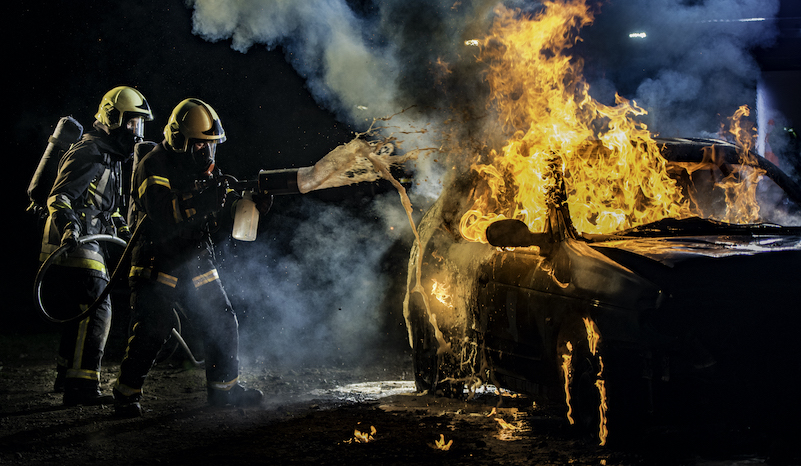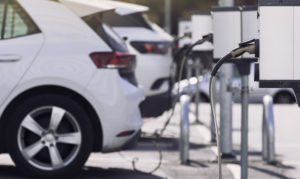
Experts say regulators need to set better electric vehicle safety standards for emergency responders.
Although an electric vehicle is significantly less likely to catch fire than a gas or hybrid vehicle, one fire department chief calls electric vehicles that do catch fire “trick birthday candles” because of the challenges these cars can present to firefighters.
After a recent Tesla crash, firefighters spent five hours battling the resulting vehicle fire. The firefighters put out the flames and sent the car to an impound lot, where the car reignited. Five days later, the car burst into flames again.
Taking note of this phenomenon, fire protection experts have criticized the lack of U.S. safety regulations aimed toward preparing firefighters to handle these fires safely.
Electric vehicles run on high-voltage lithium ion batteries, which can result in dangerously high temperatures if these cars catch fire. Emergency responders are also at risk of electric shock from damaged lithium batteries when handling electric vehicles that catch fire.
The National Transportation Safety Board (NTSB), a government watchdog that makes recommendations on vehicle safety, recently noted that emergency responder guidebooks are largely inadequate. NTSB found current guidebooks suffer from a lack of knowledge about safety standards for responders, and would benefit from more research on how batteries malfunction after crashes.
Overall, the NTSB found that half of all U.S. fire departments are not prepared to handle electric vehicle fires, and nearly one-third of fire departments have no specific training for electric vehicle or hybrid cars that catch fire.
Experts say firefighters need to know the best ways to extinguish these fires. To extinguish an electric vehicle fire, firefighters must often spend hours dousing the car with water. One fire department reported using more than 28,000 gallons of water on a single electric vehicle fire—an amount equal to what the fire department normally uses in a month.
Electric vehicles, however, may actually be less dangerous to consumers than gas or hybrid vehicles. A recent study published by an auto insurance company found that although electric vehicles often burn longer, gas and hybrid vehicles are significantly more likely to catch fire.
The insurance company estimated that, for every 100,000 hybrid and gas vehicles sold, roughly 1,500 to 3,400 caught fire, respectively. In comparison, only 25 electric vehicles have caught fire for every 100,000 sold.
Despite the fact that electric vehicles are less likely to catch fire than other cars, improving firefighter safety protocols will be necessary as the market grows. In the United States, the Biden Administration has called for half of all new vehicles sold to be zero-emissions by 2030.
Although replacing gas-fueled vehicles with electric is important to reduce greenhouse gas emissions, an increase in electric vehicles may also present more challenges for firefighters.
Accordingly, the NTSB has not called for fewer electric vehicles to be sold, but rather it has acknowledged the need for safety reform. The NTSB, however, lacks the power to implement regulations to protect emergency responders. That power lies with the National Highway Traffic Safety Administration (NHTSA), an agency within the U.S. Department of Transportation.
NHTSA has taken some actions to establish U.S. electric vehicle manufacturing standards. For example, NHTSA mandates that electric vehicle manufacturers put some safety measures in place, such as requiring protection against electric shock hazards. But NHTSA’s standards are currently silent on managing electric vehicle fires.
More broadly, in 1998 the United States signed a United Nations agreement that creates “global technical regulations” for vehicles. Recently, the United Nations recognized the need for testing the accelerated heating of electric vehicle batteries after a crash, but noted that these tests are not currently adopted as requirements for signing countries.
In the interim, some experts suggest that the actions of other countries and companies may affect global manufacturing and safety standards.
China, which some analysts project will take up 60 percent of the electric vehicle market by 2024, has issued its own national safety standards. Recognizing that an electric vehicle battery’s temperature quickly accelerates after a collision, one current Chinese standard requires that the battery will not catch fire or explode for five minutes—giving passengers time to escape safely.
Some experts expect that, because China is the largest consumer of electric vehicles, Chinese regulations may influence manufacturers worldwide as manufacturers would not want to be excluded from the Chinese automobile market.
A private company is working on a technological solution: a thermoplastic box surrounding a car’s battery. Thermoplastic can help prevent dangerous electric vehicle fires as it does not burn or melt easily as aluminum, which is traditionally used in vehicles’ battery cases. These thermoplastic cases, however, may not be available until 2024.
In the meantime, the NTSB argues that NHTSA needs to conduct more in-depth safety research and pressure manufacturers to create better emergency response guides.



